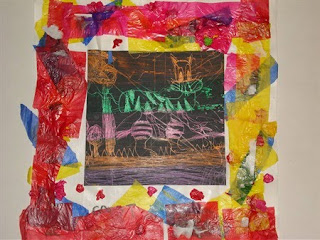It's always in the back of my mind how to validate to all the 'non-believers' how and why art is a valid subject and important skill to learn in school. This is something that so many art teachers deal with everyday. Every time we plan a lesson, give a presentation, or go on an interview the question of 'why art?' always seems to be on the tips of everyone's lips. This question is especially pressing because with so many budget cuts, policy reforms, and teacher layoffs we really are forced to not only explain but also demonstrate why we do what we do and how our children benefit. I work in a charter school that has, previous to this year, never had art. Thankfully I have a principal that supports the arts but my main focus is to use the arts to support what's being learned in the general education classroom. I'm sorry to say that the days of 'art for arts sake' are, for the most part, long gone. So, in my attempt to create engaging and meaningful lessons in both the general education domain, as well as the visual arts domain I've been developing lessons that integrate specific concepts or ideas I've seen being taught in my schools k-5 classrooms. Let me also give credit to some of the great art ed blogs out there, whose ideas other teachers have shared have really been an inspiration (and big help) in coming up with a lot of ideas.
I got this lesson from 'ArtSmarts' and I adapted the closing portion of the lesson ti include some ELA.
I started off by showing the kindergartners the online story 'Lizzy and Gordon Visit the Sculpture Park' found on www.nga.gov/kids (the national gallery of art) and I then showed them pictures in PowerPoint of the actual sculptures in the story. They particularly liked the thinking rabbit! We then discussed the difference between 2D and 3D, with 2D being 'flat like a pancake'. As a followup to the sculpture, I had them draw a 2D representation on white 8 1/2 x 11" paper and then hand the do a writing piece to accompany both.
The writing sample was based on a chart their classroom teacher had made of direction words, i.e. below, beneath, above, on top of, underneath, behind, etc. We brainstormed these words, then I wrote a sample description of my playground with them on the board. They basically had to write: 'My playground is ______________ (descriptive word). The blue swing is next to the yellow slide. The green pond is below the purple bridge...' The task required the use of 3 direction words and some sort of description. Overall the end results were really great! I'm glad to have found this lesson and satisfied with the idea that I can teach the kids something about art (for arts sake) while also reviewing things they learn in their classrooms!





